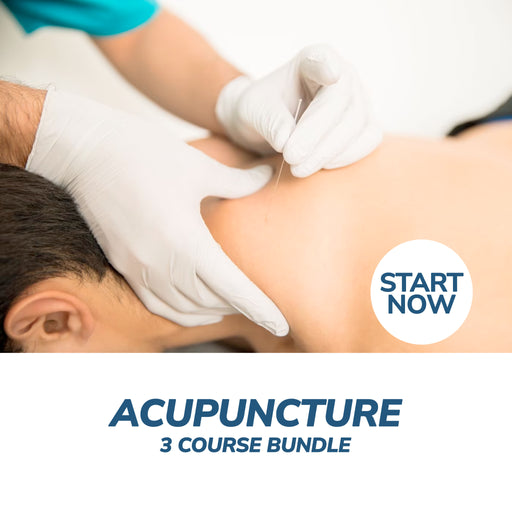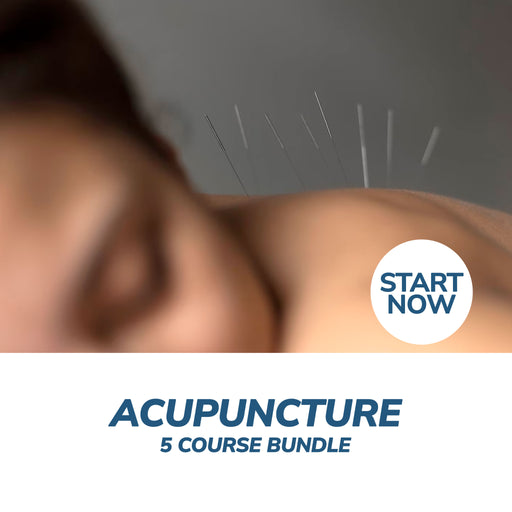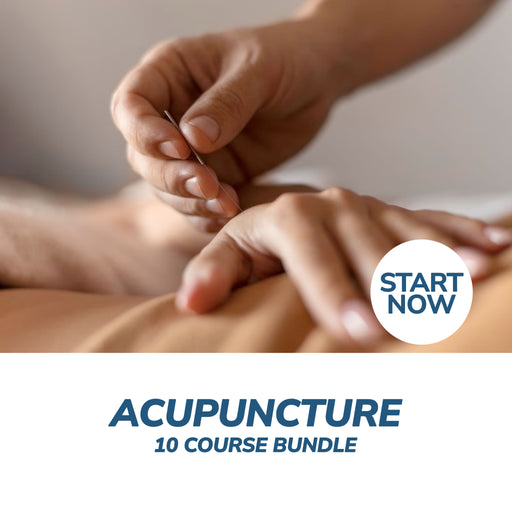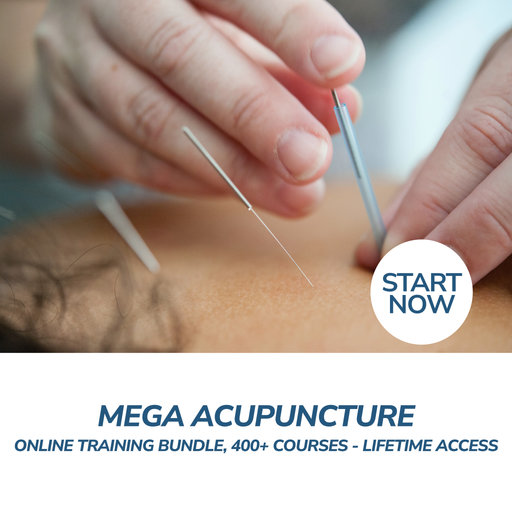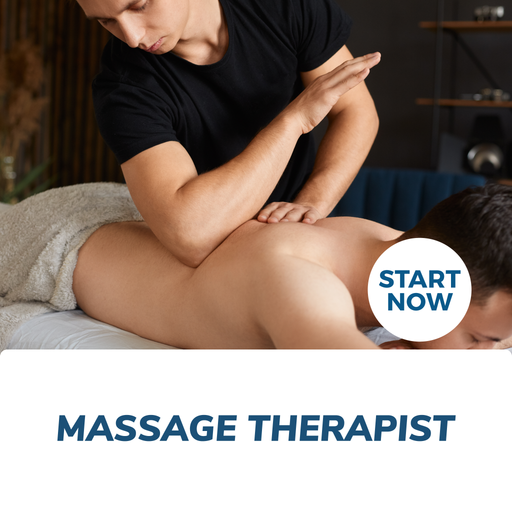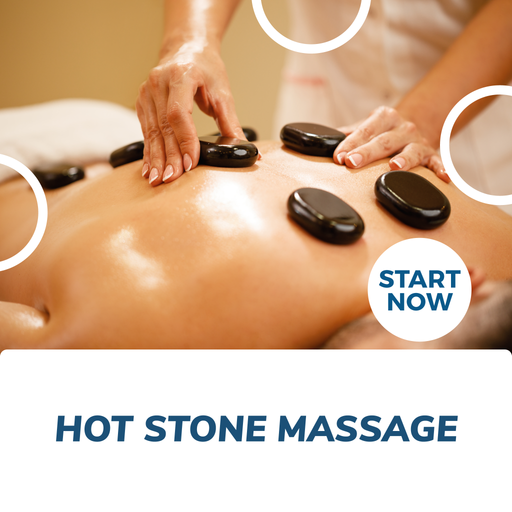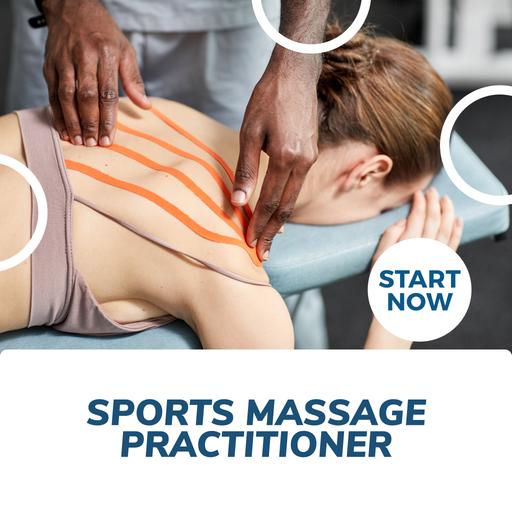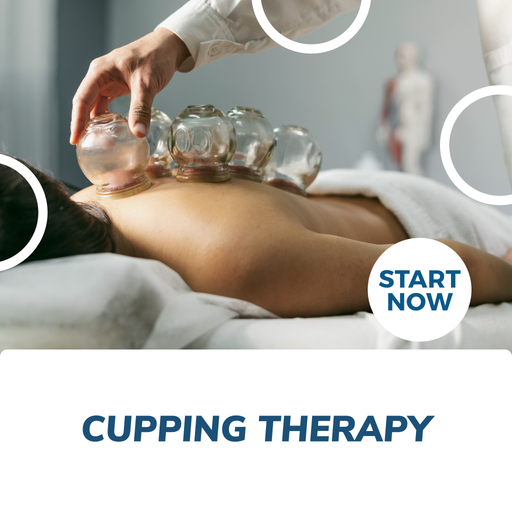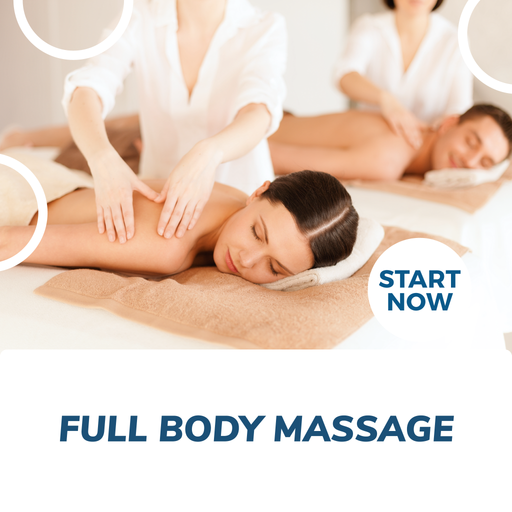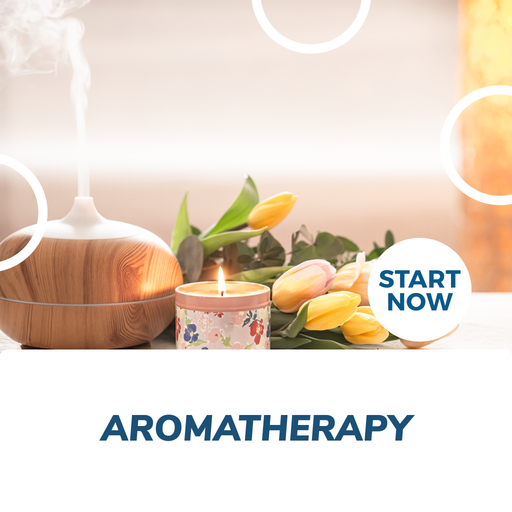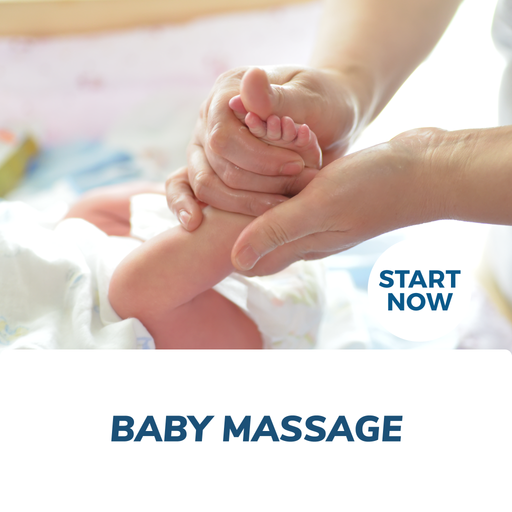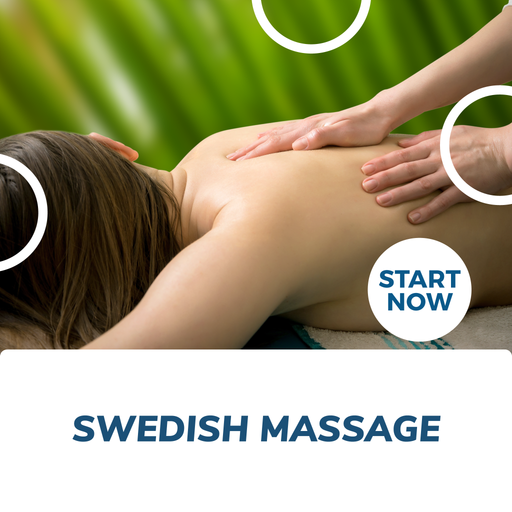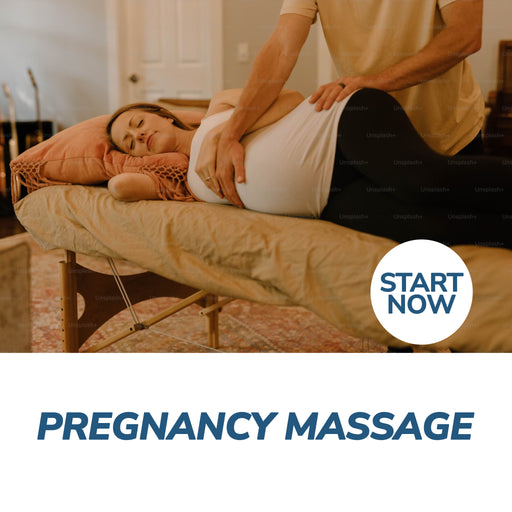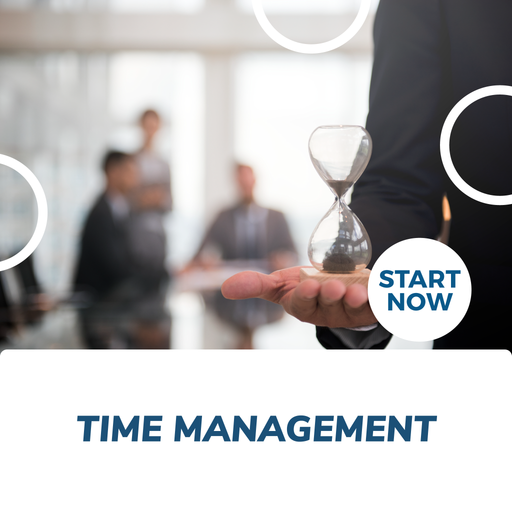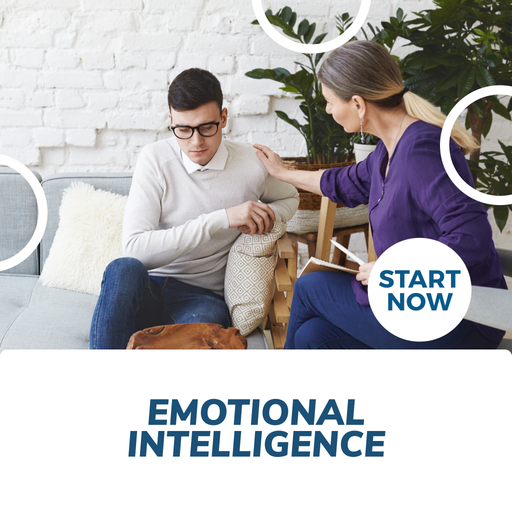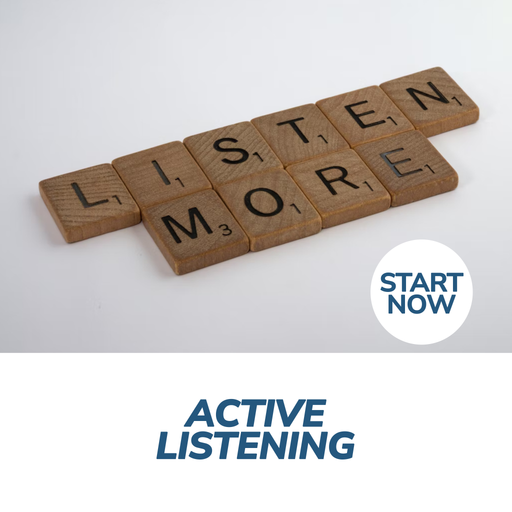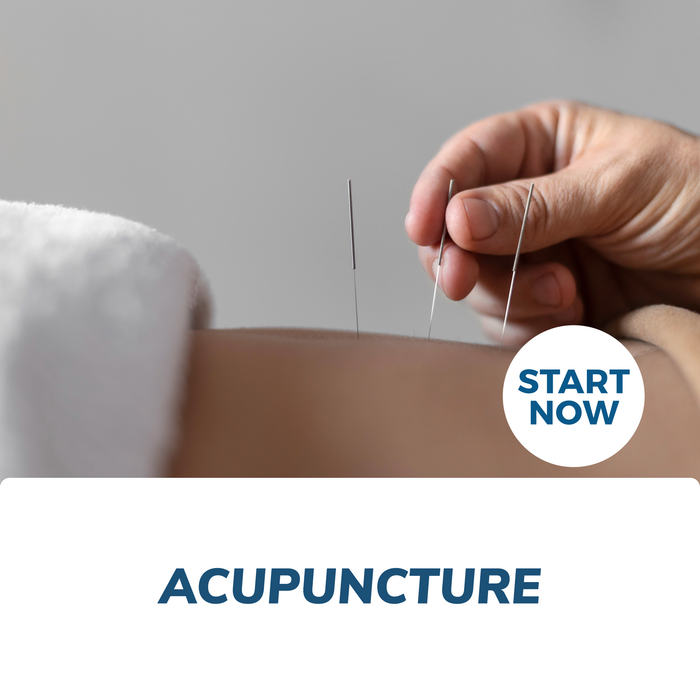
About This Course
What you will learn
|
|
Study Acupuncture Online Course and Get a Better Understanding about the Different Theories and Concepts Behind Acupuncture
Acupuncture is well-known, yet few people are aware of its genuine purpose. Our Acupuncture Online Course will help you obtain a thorough grasp of what acupuncture is, the principles and theories that underpin it, the skills and methods employed in its practice.
You will understand the origins of disease seen through traditional Chinese medicine's eyes and an overview of the meridian system and the twelve main meridians. After you have this information, you will be carried through a list of many individual acupuncture points, purposes, and placements.
The course introduces the problems that Acupuncture may help with and the safety and dangers associated with this type of therapy. It is crucial to understand how the body works and the fundamental processes that keep it running to give acupuncture.
This knowledge is provided throughout the course, which walks you through the elements of each structure and how they function. The Health and Complementary Therapies Online Courses also shows how to utilize practices to help you develop your profession.
On completion of this course, which you can access online with any device, you receive your certification which is industry recognised. All certifications can be verified via the website, giving prospective employers complete peace of mind when confirming your credentials. For more information on our popular Introduction to Acupuncture Online Courses, you can visit us here at Courses For Success!
Acupuncture Online Course - Requirements
The Acupuncture Course is delivered 100 percent online 24/7.
To successfully complete this course, a student must:
- Have access to the internet and the necessary technical skills to navigate the online learning resources
- Have access to any mobile device with internet connectivity (laptop, desktop, tablet)
- Be a self-directed learner
- Possess sound language and literacy skills
Quick Course Facts
- Course content is structured for easy comprehension
- Registered students gain unrestricted access to the Acupuncture Course
- All course material is available online 24/7 and can be accessed using any device
- Study online from anywhere in your own time at your own pace
- All students who complete the course will be awarded with a certificate of completion
For any additional questions please see our comprehensive FAQS tab above.
Acupuncture Online Course Outline
Module 1: Introduction
This is the course's introductory module. In this first session, we will talk about acupuncture as a profession and look at some historically important events in its evolution.
Acupuncture as a Practice
Acupuncture is an enthralling and gratifying discipline. It is a medical specialty that entails the insertion of metal needles into the skin at specified places. Electrical activity or the practitioner's hand are used to activate the needles. Acupuncturists address illness treatment and health care development from a holistic perspective.
A Brief History of Acupuncture
Acupuncture dates back to the stone era when abscesses were drained and punctured using sharp-edged stones and other sharp-edged implements. Acupuncture was initially recorded in The Yellow Emperor's Classic of Internal Medicine, a traditional Chinese medical literature written by Huang Do Nei Jing around 100 BCE.
Popularity Over Time
Acupuncture has gained popularity as a therapeutic medical therapy during the last 40 years. In the United States, it has become one of the most extensively utilized alternative medicinal therapies. Acupuncture therapy cases in the United States total more than 10 million each year. The popularity of acupuncture in the West is primarily due to its success in providing pain alleviation and tangible evidence of its usefulness from medical specialists.
Module 2: Benefits and Contraindications
The advantages of acupuncture will be discussed in Module 2 and why individuals keep seeking this type of treatment. Acupuncture contraindications and when it is not suggested for safety concerns will also be discussed.
Benefits
Acupuncture is well-known for its effectiveness in treating chronic pain, but it may also treat a range of other ailments. Acupuncture also has other advantages, such as increasing mood, reducing migraine symptoms, and enhancing sleep quality. Acupuncture treatments can help patients suffering mood swings due to hormone imbalance, stress, or worry. The central nervous system is stimulated both during and after the needles are inserted. It enables the body to produce endorphins and other mood-enhancing substances.
Duration of Effect
Acupuncture has a short-term impact. Individuals with more severe symptoms may not have the same long-term pain alleviation as those with less severe symptoms. It is tough to say how long the effects will continue because everyone is different.
Case Study: Sample Points
Acupuncturists can choose between a list of 361 primary points and 48 optional points to identify where the needles should be inserted for the best outcomes, depending on the disease being treated. An international standard has established these points.
Contraindications
For certain people, there are specific contraindications or limits, like with any medical treatment. A person should not utilize acupuncture as a type of treatment if they have any of the following problems.
- Bleeding disorder, including haemophilia or anyone who is currently using blood thinners
- A seizure disorder
- Drug or alcohol intoxication
Module 3: Anatomy
Anatomical understanding has always been essential for acupuncture. This lesson will look at the body's primary physiological systems and how they interact with one another. Acupuncturists must complete rigorous training to detect points and accurately insert needles, which is one of the reasons they must study for so long.
Anatomy in Context
The first human body model for medical education was created in China to teach prospective acupuncturists. The Imperial physician Wang Wei-Yi sculpted the Bronze Statue of Acupuncture (or "Copper Man") in 1027. An effective acupuncture practice still requires anatomical understanding. It guarantees that the procedure is carried out safely and that needles do not puncture nerves or blood vessels.
Structural Components
Cells, tissues, organs, and organ systems are the four primary categories of smaller structures that make up the human body.
Cells
A cell is the tiniest living unit capable of performing all of life's tasks. Bacteria, for example, are tiny single-celled creatures that exist autonomously.
Tissues
Tissues are made up of a group of cells that have similar tasks. Intercellular substances link the cells inside tissues. The four essential tissues present in the human body are muscle tissue, nerve tissue, connective tissue, and epithelial tissue. Each one is composed up of the following cells that work together to accomplish a specific task.
Organs
Organs are composed of a variety of tissues that collaborate to perform their physiological functions. It is made up of two or more different types of tissues. All four kinds of tissue can be found in the heart and stomach (muscle, nervous, connective, and epithelial). The stomach digests food, but the heart maintains blood circulating by pumping at regular times.
Organ Systems
Organ systems are the most complicated components of the human body. They are composed of a variety of organs that collaborate to perform complex tasks. They also work together to help one another develop, reproduce, and survive. They depend on each other to fulfil tasks that separate systems are incapable of completing. Because many organs perform several duties, they can be found in multiple systems.
Homeostasis
The term "homeostasis" refers to the body's ability to maintain controlled circumstances. Several functions that contribute to homeostasis have been discussed throughout this course. The management of blood pressure is another example. If abnormal blood pressure is recognized, the brain sends messages to the heart to reduce or speed up the heart rhythm.
Physiological Systems
The human body has ten primary systems that function together, as we discussed. We will go through each of them in further depth now.
The Skeletal System
Soft tissues in the body are supported and protected by the skeletal system. Bones, cartilage, ligaments, and tendons make up the skeleton of the body. The human skeleton accounts for around 20% of body mass.
The Muscular System
The muscular system, in concert with the joints and bones, allows the human body to move. Muscle contractions, which are essential in maintaining body temperature, generate heat as a consequence.
The Nervous System
The nervous system takes signals from both within and outside the body and conveys them to the brain, assisting in maintaining homeostasis (along with the endocrine system). The central nervous system (CNS) and the peripheral nervous system (PNS) are the two primary subsystems of the nervous system (PNS). The CNS, which comprises the brain and spinal cord, manages to get and process signals from the PNS.
The Endocrine System
The endocrine system is intertwined with the neurological system, as previously stated. While the neurological system uses electrical impulses to communicate, the endocrine system uses hormones, chemical messengers that regulate metabolic activity.
Cardiovascular System
The heart is part of the cardiovascular (circulatory) system, including a complex network of arteries, veins, and capillaries. This system helps blood flow throughout the body, delivering oxygen and nutrients and transporting waste items to their proper destinations.
The Lymphatic System
Pathogens are fought off by the lymphatic (or immunological) system. Lymphocytes, a kind of white blood cell, are in charge of safeguarding humans against alien microbes.
The Respiratory System
A constant supply of oxygen is required by all cells. In tandem with the circulatory system, the respiratory system guarantees that oxygen is provided and metabolic waste is eliminated. Respiration is the process of exchanging oxygen and carbon dioxide between the outside environment and the cells.
The Digestive System
Food is processed in the digestive tract for absorption so that cells can utilize energy and nutrients. The digestive tract is part of the system, as are numerous other organs. Inside the body, food travels through three stages: digestion, absorption, and excretion.
The Urinary System
The urinary system keeps the body's fluids at the right volume and composition. The kidneys and the bladder are the two principal organs in the system. Blood travels via the kidneys, which filter out any superfluous or hazardous compounds.
Reproductive System
The reproductive system, unlike all other systems, strives to ensure the survival of the species. When an egg is fertilized, the reproductive system creates hormones and reproductive cells (egg and sperm), transports these cells, and promotes the normal development of kids.
Module 4: Meridians
Probing acupuncture sites along meridians is a part of acupuncture treatment. Needling, pressure, and heat are used to probe the skin. This module will go over what meridians are, where they're found, and which organs are connected to them. For best performance, detailed comprehension of the meridian pathways and their related symbols is required.
Defining Meridians
Acupuncture points are connected by meridians, which are channels. Each meridian channel is part of a network of connecting meridians that travels along the body. They make it easier for the life force to flow (Qi). Meridians function similarly to the circulatory system but without the physical shape.
The 12 Meridians
Meridians go down both sides of the body. The meridians on the left side of the body are the exact opposite of those on the right. Each meridian is connected with a separate organ, which acts alone and in tandem with other organs. All of the organs, however, are dependent on the proper functioning of the entire meridian network.
Organs
The 12 meridians are named after the organs with which they are related. The triple energizer is the only one of these meridians that are not named after an organ.
The Heart
A healthy heart is necessary for the proper functioning of all of the organs. The heart collaborates with a variety of other organs to keep the mind and body in good shape. An unbalanced heart is the source of many physical and mental problems.
The Lungs
Respiratory infections, breathing difficulties, and skin problems can all be caused by lung meridian dysfunction. When it comes to fighting external infections, the lungs are first in line.
The Pericardium
This is a portion of an organ, not an organ in and of itself. The pericardium is a two-layered bag that surrounds and protects the heart against infection. Its unbalance can cause problems with the heart, chest, and stomach.
The Spleen
The spleen uses specific enzymes to absorb nutrients from meals. It controls the volume and quality of blood that circulates in the body. A spleen meridian imbalance impairs intellect and might lead to irritation.
The Kidneys
Both males and females have adrenal glands and sex glands in their kidneys. Urinary infections and impotence can be caused by renal meridian dysfunction.
The Liver
The liver cleanses the blood and converts nutrients into energy-producing molecules for the body. Imbalances in the hepatic meridian can cause hypertension and anxiety.
The Large intestine
By generating waste, the large intestine helps to maintain the body's fluid equilibrium. Stomach problems can include abdominal discomfort, constipation, or diarrhoea.
The Small Intestine
Food is sent from the stomach to the small intestine, broken down, and nutrients extracted. Appetite difficulties, such as an impulse to overeat or a lack of appetite, can be caused by imbalances in the small intestine meridian.
The Triple Energizer
This meridian has nothing to do with a specific organ. The energy metabolism, digestion, and waste evacuation are aided by the top, middle, and lower regions of this meridian.
The Gall Bladder
Through its contents, the gall bladder aids indigestion. As a result of the digestive process, energy is released, which is utilized by the muscles.
Stomach
The stomach meridians transmit energy throughout the meridian system by using meals as a form of energy. Any gastrointestinal problems might induce an energy shortage in the meridian system, resulting in stress and disorientation.
The Bladder
The bladder is responsible for storing and eliminating liquid waste products from the body. Inconsistencies in its functioning might cause urinary issues and back discomfort.
Module 5: Extraordinary Points and Vessels
We will learn about remarkable points and how they are employed in acupuncture in this section. It will contain a description of the exceptional vessels and how they are employed in TCM.
Extraordinary Points
Non-meridian points, also known as great points, are not situated along the 12 main meridians. A handful of exceptional meridian points are distinct from those found anywhere along twelve different meridians.
Using Extraordinary Points
Each location is supposed to be capable of treating over 20 symptoms and illnesses. As a result, it is crucial to research these extra points and their relationships and trends. Traditional Chinese Medicine places a high value on patterns. Pattern recognition is critical in relieving acute illnesses, and it is linked to positive results.
Example: Extraordinary Point Shixuan
Observe Shixuan, a unique point. The English translation is "Ten Dispersions," It is found on the ends of each finger, with ten of them on both hands. Coma, epilepsy, a high temperature, and a scratchy throat are some of the symptoms that might occur.
Extraordinary Vessels
The meridian sector is governed by extraordinary vessels. The Ren Mai and Du Mai vessels are two of the eight deep reservoirs, although only the Ren Mai and Du Mai vessels have acupuncture sites. The last six are a bit of a mystery. There is a need to learn more about them, but the outcomes are frequently confused and contradicting.
Module 6: Acupuncture Theory
The theory of acupuncture will be discussed in this module. As there are so many acupuncture schools, the actual foundation of the technique varies depending on the history.
Yin and Yang
Harmony and balance are the foundations of Yin and Yang. For generations, TCM has employed this symbology. The primary idea of Yin and Yang is that these opposing yet complementary energies control every human.
The Yin Yang Symbol
A dark and passive side traditionally represents the Yin Yang sign's feminine, negative, and frigid side. The Yin side is this. Light, dynamic, masculine, optimistic, and pleasant characterizes the Yang side of the sign. The Yin and Yang sign may also be used to highlight that everything has two sides—tired and active, happy and sad, cold and hot. Yin and Yang are two total opposites that combine to form wholeness.
Other Ancient Treatments
The theory of Tridoshas in Ayurveda, an ancient Indian treatment, can be compared to the concept of Yin and Yang. Ayurvedic practitioners believe that everyone possesses Vata, Pitta, and Kapha. We observe a condition of perfect health when all of these aspects are harmonized.
Yin and Yang in Acupuncture
One of the significant goals of acupuncture is to assist the patient to maintain a healthy Yin-Yang balance within themselves. It will aid in the prevention of health problems and the treatment of any present illnesses or abnormalities. Acupuncture is regarded as a Yang treatment. This is because it goes from the outside to the inside of the organism.
Cause of Disease
We will go through the Qi principle once again. Energy circulates all through the system, according to TCM, and is mainly accountable for our vitality and well-being. When the Qi is disrupted, it causes sickness, diseases, and problems with our bodily and mental health. Acupuncture at specific sites is said to promote Qi flow and thereby improve a variety of health issues.
The Five Elements Theory
All-natural occurrences are divided into five categories under the Five Elements Theory: wood, fire, earth, water, and metal. These groupings, particularly the five primary viscera, provide a template for how nature interacts with our bodies. It is also thought that each of the five elements has a distinct personality associated with it.
Wood: Liver
The liver is the first organ that is stressed as a result of our emotions. If you are frequently annoyed, it is a sign that your liver is out of balance. Wood is related to the liver. This is because wood is a symbol of strength. It symbolizes progress, transformation, and the ability to persist.
Water: Kidney
Because of our emotions, the liver is the principal organ that suffers from stress. If you are frequently annoyed, it is a sign that your liver is out of whack. Wood has a strong connection to the liver. This is since wood is synonymous with toughness. Growth, change, and the ability to persist are all represented by this symbol.
Fire: Heart
Staying physically healthy is only one aspect of heart health. You must also be satisfied with your life and general trajectory. The heart is connected with happiness and love, but stress and a lack of self-expression can hinder its function. Fire is linked to the heart.
Metal: Lungs
When we are dealing with a lot of loss and grief, our lungs tend to suffer. Allowing things to go can aid in the stimulation of lung function, allowing them to operate appropriately. Metal is related to the lungs. They are regarded as the body's reservoir of fluid, and they are nourished by the Zong or collecting Qi, which aids in the proper functioning of the chest vitality.
Earth: Stomach
Stress, anxiety, and worry may wreak havoc on the stomach. You will have a slow metabolism and poor digestive health if this organ is not working correctly. The stomach is linked to the planet Earth. The stomach is related to late summer, which is harvest time, in the five-season cycle. It symbolizes how a harvest's promise is the climax of the human body.
Module 7: The Acupuncture Process
In Module 7, we will go through the entire acupuncture procedure and how most customers' sessions go. It might differ based on the practitioner's preferences and the specific desires of the customer.
Duration
Initial consultations and examinations typically last around an hour. Depending on the client's goals, subsequent treatments may be shorter. The number of treatments required will be determined by the kind and severity of the disease. A given ailment is usually treated with six to eight sessions.
Performing the Procedure
Clients will recline on a comfortable table under a robe or towel for modesty during the process. Some customers may be apprehensive and request more information regarding how and where needles will be utilized. At appropriate spots on the body, the practitioner will implant needles to varying depths. These locations might be a long way from the treatment room.
Results
After therapy, many say they feel calmer and more rejuvenated. The procedure, however, does not work for everyone. Acupuncture may not be acceptable if clients do not perceive any change after a few weeks.
How to Select Points
The number of points used in acupuncture altered as the practice spread across Asia. The Scientific Group of the World Health Organization (WHO) has approved a global convention for acupuncture that includes 361 primary points and an extra 48 points.
Acupuncture and Related Techniques
Different techniques and practices have been adopted as acupuncture has progressed across Asia. Most acupuncturists now mix parts from ancient treatments with current technologies to develop a different style.
Traditional Chinese Acupuncture
Acupuncture in this form is the most common. Remember that external and internal, hot and cold, Yin and Yang, excess and not excess are all terms used in Traditional Chinese Medicine to describe the body's natural movements.
Tongue Diagnosis
For a diagnosis to be determined, a thorough examination of the tongue is required. Headaches, arthritis, depression, anxiety, and sleeplessness have all responded well to this method.
Japanese Acupuncture
To achieve the most significant change in the body, the Japanese method promotes employing minimum stimulus. As a result, this therapy requires fewer needles. The faults are identified using diagnostic tools. To rectify bodily imbalances, thinner needles are implanted to a shallower depth.
Korean Acupuncture
Both Japanese and Chinese acupuncture are used in Korean acupuncture. The treatment employs a more significant number of needles, typically made of copper rather than stainless steel, as is the case with other treatments.
Auricular Acupuncture
The ear is viewed as the vital body component connected to the major organs in this style of acupuncture. It is considered that imbalances in the body can be remedied by stimulating areas in the ear with needles or slight electric shocks.
Scalp Acupuncture
Fine needles are put into trigger points on the scalp in this kind of acupuncture. Acupuncture on the scalp is helpful in the treatment of spinal and motor-impairment issues.
Laser Acupuncture
This is a novel type of acupuncture that stimulates areas in the body with low-energy laser beams rather than needles. This therapy option is excellent for people who are allergic to needles.
Teishin
Teishin, a non-insertion method of acupuncture, stimulates acupoints using telescopic, blunt needles. The skin is lightly touched or tapped with these pressure needles.
Acupressure
Finger placement is used in acupressure to apply pressure to particular areas of the body. The goal of this procedure is to activate these spots without using needles. Shiatsu is a Japanese method that is similar to acupuncture and is also utilized by therapists.
Cupping
Cupping is a technique for removing toxins and clearing blockages by placing suction cups on acupoints. Blood diseases, arthritis, eczema, migraine, depression, and coughs are all treated by cupping.
Aftercare Recommendations
Encourage your client to do these measures following their acupuncture session to get the most out of their treatment.
- Get plenty of relaxation: After a session, clients feel rested and energized. However, they must relax and take things easy. They must get plenty of sleep and avoid staying up late. Resting the body after treatment allows them to derive the most significant benefit of the healing process.
- Hydrate: They should drink plenty of fluids, especially water. After acupuncture, the body will naturally want to detox. Drinking plenty of fluid helps flush all the toxins out of your body.
- Avoid exercise immediately after treatment: Remember that the body is undergoing a healing process. This requires energy, so clients should refrain from exercise and heavy physical activity so that their strength can be used to repair and rejuvenate.
Module 8: Traditional Therapies
The remaining five types of TCM will be discussed in this section. Moxibustion, Tui Na massage, cupping/scraping, Chinese medicines, and the Chinese diet are used. All of these techniques are critical in assisting people in achieving improved health.
Moxibustion
Moxibustion is a therapeutic technique that involves the use of Moxa (mugwort root). Moxa is manufactured from Artemesia Vulgaris, a spongy dried plant. The mugwort plant has long been used for various purposes, including digestive issues, insect repellant, and culinary flavour.
Tui Na Massage
For generations, Chinese people have practised Tui Na Massage. It is a type of complete bodywork therapy that incorporates a variety of modalities such as massage, acupressure, and others. The earliest system of massage or bodywork is generally referred to as this type of massage treatment. Traditional Chinese Medicine considers it to be one of the pillars. To get the best results, the procedure is frequently utilized in combination with acupuncture.
Cupping and Scraping
The fundamental goal of these treatments is to eliminate toxins from the body so that Qi may flow more freely. The procedure is also used to improve circulation. The connective tissues are loosened and freed up by cupping and scraping, allowing new, oxygenated fluid to circulate into the regions that need therapy. It also enables the removal of clogged blood, pollutants, and debris.
Chinese Herbs
Although Chinese herbs are revered for their medicinal properties, little research has been done on them. The majority of knowledge has been passed down down the generations via word of mouth. Cinnamon bark, ginseng, ginger, rhubarb, and liquorice are the most often utilized herbs. Herbs are often blended into formulae and then distributed in various forms for ingestion, including conventional tea, capsules, granules, extracts, and powders.
Chinese Nutrition
This therapy approach is more than simply a treatment; it is a way of life that is firmly ingrained in Chinese culture. It has been practised for centuries and has had significant results. A balanced diet is defined as one that includes all five spices. The effects of these spices on the human body are varied. Warming is related to spice, cooling is associated with sour and bitter, sweet is associated with strengthening, and salt is linked with cooling.
Module 9: Practitioner and Client Safety
This section of the training will focus on acupuncture safety and how to manage the risk of harmful consequences.
Risk
If the acupuncturist is well-trained and follows all health and safety regulations, the hazards of acupuncture are minimal. Acupuncture is typically safe and has few adverse effects, unlike many medication treatments and other procedures.
The Importance of Keeping Records
An acupuncturist must keep records for both financial and patient/treatment purposes. Starting with the financial side, it is critical to keep track of everything you buy and patient fees and revenue for tax considerations. Using an accountant to maintain track of all financial data might be beneficial.
Reviewing Medical Histories
Acupuncture has few dangers. However, certain persons with particular medical problems or histories may be at risk. Medical histories can also reveal whether or not someone has had a bad reaction to acupuncture in the past, as well as reasons.
Sterilization of Materials
All varieties of acupuncture have a range of techniques and uses, but they all require a sterile and clean environment to eliminate risk concerns for everyone involved. The sterilization of needles is one of the most important regulations for the safe practice of acupuncture.
Protective Equipment
Acupuncture uses protective equipment to reduce the danger of infection from possibly contaminated materials. Acupuncturists should have essential personal protection equipment on hand, in addition to soap, water, alcohol, disinfectant, and containers for biohazard materials.
Common Fears
Recognition & Accreditation
Upon successful completion of this course and achieving a passing score for the assessment, you will be issued with an international continuing education credit (CEU) certificate.
This Certificate is applicable worldwide, which demonstrates your commitment to learning new skills. You can share the certificate with your friends, relatives, co-workers, and potential employers. Also, include it in your resume/CV, professional social media profiles and job applications.
Units of Study
Module 1: Introduction
- Acupuncture as a Practice
- A Brief History of Acupuncture
- Popularity Over Time
Module 2: Benefits and Contraindications
- Benefits
- Duration of Effect
- Case Study: Sample Points
- Contraindications
Module 3: Anatomy
- Anatomy in Context
- Structural Components
- Cells
- Tissues
- Organs
- Organ Systems
- Homeostasis
- Physiological Systems
- The Skeletal System
- The Muscular System
- The Nervous System
- The Endocrine System
- Cardiovascular System
- The Lymphatic System
- The Respiratory System
- The Digestive System
- The Urinary System
- Reproductive System
Module 4: Meridians
- Defining Meridians
- The 12 Meridians
- Organs
- The Heart
- The Lungs
- The Pericardium
- The Spleen
- The Kidneys
- The Liver
- The Large intestine
- The Small Intestine
- The Triple Energizer
- The Gall Bladder
- Stomach
- The Bladder
Module 5: Extraordinary Points and Vessels
- Extraordinary Points
- Using Extraordinary Points
- Example: Extraordinary Point Shixuan
- Extraordinary Vessels
Module 6: Acupuncture Theory
- Yin and Yang
- The Yin Yang Symbol
- Other Ancient Treatments
- Yin and Yang in Acupuncture
- Cause of Disease
- The Five Elements Theory
- Wood: Liver
- Water: Kidney
- Fire: Heart
- Metal: Lungs
- Earth: Stomach
Module 7: The Acupuncture Process
- Duration
- Performing the Procedure
- Results
- How to Select Points
- Acupuncture and Related Techniques
- Traditional Chinese Acupuncture
- Tongue Diagnosis
- Japanese Acupuncture
- Korean Acupuncture
- Auricular Acupuncture
- Scalp Acupuncture
- Laser Acupuncture
- Teishin
- Acupressure
- Cupping
- Aftercare Recommendations
Module 8: Traditional Therapies
- Moxibustion
- Tui Na Massage
- Cupping and Scraping
- Chinese Herbs
- Chinese Nutrition
Module 9: Practitioner and Client Safety
- Risk
- The Importance of Keeping Records
- Reviewing Medical Histories
- Sterilization of Materials
- Protective Equipment
- Common Fears
Module 10: Acupuncture Efficacy
- Conditions
- Major Organizations
- Case Study: Schizophrenia
Module 11: Qualifications and Career Outlook
- Requirements
- Personal Qualities
- Salary Range
- Career Outlook
Module 12: Business and Marketing
- Equipment and Tools
- Suppliers
- Example Business Model for Acupuncturists
- Types of Marketing
- How to Build a Clientele
- Create a Website
- Be Present Online
Requirements
Entry requirements
Students must have basic literacy and numeracy skills.
Minimum education
Open entry. Previous schooling and academic achievements are not required for entry into this course.
Computer requirements
Students will need access to a computer and the internet.
Minimum specifications for the computer are:
Windows:
Microsoft Windows XP, or laterModern and up to date Browser (Internet Explorer 8 or later, Firefox, Chrome, Safari)
MAC/iOS
OSX/iOS 6 or laterModern and up to date Browser (Firefox, Chrome, Safari)
All systems
Internet bandwidth of 1Mb or fasterFlash player or a browser with HTML5 video capabilities(Currently Internet Explorer 9, Firefox, Chrome, Safari)
Students will also need access the following applications:
Adobe Acrobat Reader
Requirements
Entry requirements:
Students must have basic literacy and numeracy skills.
Minimum education:
Open entry. Previous schooling and academic achievements are not required for entry into this course.
Device requirements:
Students will need access to a computer/any device and the internet.
FAQS
1. Who are Courses For Success?
Courses For Success is a course platform that started in 2008
with 5 courses, since then we have grown to over 10,000 online courses.
Our courses span across the following categories:
•Animal
•Beauty
•Business
•Health & Fitness
•Finance
•Lifestyle
•IT & Software
•Personal Development
•Teaching & Academics
2. Is there a refund/cancellation policy?
Yes, we have a 7-day money-back refund guarantee. Just send us an email to info@coursesforsuccess.com with the subject Courses For Success Refund so we can accommodate your request.
3. What is the FREE Personal Success Training Program?
The Personal Success Training Program
was developed by Courses For Success to help our customers achieve
success. Currently, we are offering this program for FREE with every
course or bundle purchase this month. This is a limited time offer!
4. Are there any requirements to study this course?
No,
anyone who has an interest in learning more about this subject matter
is encouraged to take our course. There are no entry requirements to
take this course.
5. Do I require to have finished high school to complete this course?
No,
you do not require a High School Diploma or to have finished school to
study this course, this course is open to anyone who would like to take
this course.
6. What if English is not my first language?
This
course is provided in English, however, due to the digital nature of
our training, you can take your time studying the material and make use
of tools such as google translate and Grammarly.
7. Is this course online or conducted in person?
All our courses are accessible online on any device. You may complete them at your own pace and at your own time.
8. How do I receive my course?
After
you have completed the payment, you will receive a confirmation email
and tax receipt. You will also receive an email containing your course
login details (username and password), as well as instructions on how to
access and log in to your course via the internet with any device,
please check your junk/spam folder in the event that you do not receive
the email.
9. When does this course start?
Providing
you have internet access you can start this course whenever you like,
just go to the login page and insert your username and password and you
can access the online material.
10. What is online learning like?
Online learning is easy, if not easier than a traditional academic situation.
By studying an online course, the usual boundaries caused by location and time constraints are eliminated, meaning you are free to study where and when you want at your own pace.
Of course, you will need to be able to self-manage your time and be organized, but with our help, you’ll soon find yourself settling into a comfortable rhythm of study.
11. What computer skills do I need for my course?
You
don't need to be a computer expert to succeed with our online training,
but you should be comfortable typing, using the internet and be capable
of using common software (such as Microsoft word).
12. How long will you have access to the online course?
The majority of our courses have unlimited lifetime access, meaning you can access this course whenever you want.
Please also check the course summary, as a small selection of courses have limited access.
13. How long will my course take?
Course duration, is listed under Course Summary
14. Do I need to buy textbooks?
All the required material for your course is included in the online system, you do not need to buy anything else.
15. Is the course interactive?
Yes, all our courses are interactive.
16. Is there an assessment or exam?
Yes,
you will be required to complete a multiple-choice test online at the
end of your course, you can do this test as many times as you require.
17. What type of certificate will I receive?
You
will receive a Certificate of Completion that is applicable worldwide,
which demonstrates your commitment to learning new skills. You can share
the certificate with your friends, relatives, co-workers and employers.
Also, include it in your resume/CV, professional social media profiles
and job applications.
Wendy Sue Hunt - 5 STAR REVIEW
"If you are considering taking any “Courses for Success”, I would highly recommend it. I have always been a firm believer it’s important to always sharpen your skills. You are never too old to learn more. I found the courses very helpful, interesting and easy to understand.
The term “Courses for Success” helped me in my current position to succeed. After completing the courses, I gave my manager the completion certificates. Recently I received a promotion too."
Valencia Marie Aviles - 5 STAR REVIEW
"I
had a very good experience with my course. It has helped me to get
multiple jobs and prepared me for almost everything I would need to
know. The course was very informative and easy to understand and broken
up perfectly to be done in a short amount of time while still learning a
good amount! I would recommend Courses for Success to anyone trying to
get abs certifications for job advancements, it is well worth it!"
ELENA GRIFFIN - 5 STAR REVIEW
"I have absolutely enjoyed the materials from Courses for Success. The materials are easy to understand which makes learning enjoyable. Courses for Success have great topics of interest which make you come back for
more.
Thank you Courses for Success for being part of my learning journey and making education affordable!"
Our
completion certificates are very valuable and will help you progress in
your work environment and show employers how committed you are to learn
new skills, you might even get a promotion.
18. Will this course be credited by universities?
No, it is not equivalent to a college or university credit.
19. Am I guaranteed to get a job with this certificate?
This course will give you the skills you need to help you obtain employment, but it’s up to you if you get the job or not.
20. How will this course assist me with my career?
Studying
and completing this course will show employers that you have the
knowledge in this field, additionally you will gain more confidence in
this area of expertise.
21. How long is the certificate valid for?
The Certificates are valid for life and do not need renewing.
22. Can I take more than one course at a time?
Courses
are studied online at your own pace and you are free to study as many
or as few courses as you wish, we also offer online course bundles that
allow you to save on additional courses so that you may get all the
topics related to your training goals in one go.
23. What are the Payment Methods available? Is there a payment plan?
We accept payments via PayPal, Credit Card and Bank Transfer.
Payment Plans: We have partnered with Partial.ly, to offer our own in house payment plan. Everyone is Pre-Approved, providing the initial deposit is paid in full.
To pay via bank transfer contact us info@coursesforsuccess.com
24. Can I purchase for multiple people?
Yes, you can do this by purchasing individually via website or send us a request via email at info@coursesforsuccess.com
25. Can I request for an invoice before purchase?
Yes, you can request for an invoice via email at info@coursesforsuccess.com
26. Purchase for a gift?
Yes, you can purchase this course as a gift, simply send an email to info@coursesforsuccess.com, with the course details and we can accommodate this.
27. Can I create my own course bundle?
Yes,
you can customize your own bundle. Please send us the complete list
with the exact course link of the courses you'd like to bundle up via
email info@coursesforsuccess.com and we will create them for you. *Each course access, time of completion and certification varies depending on the course type.
28. How will I contact Courses For Success if I have any questions?
You can contact our support team, at any time through live chat on our website, or email at info@coursesforsuccess.com, or by calling one of our phone numbers depending on which country you are in.
Free Personal Success Training Course
The Personal Success Training Program Helps You Stay Focused To Achieve Your Goals!
This month, we are providing it for Free with all Course Purchases, as a special offer!
Benefits:
• How to layout a Success Plan.
• Get where you want to be in life.
• How to unclutter your mind to succeed.
• Achieve your dreams using your imagination.
• How to have faith in yourself.
Features:
• Life time access
• Complement your individual course purchase.
• Click here Personal Success Training Program to see thousands of positive reviews,
Hurry - offer - ends this month!
Course Bundles
Looking for specific training for yourself or employees. Choose from our Course Bundles below or build you own Bundle, by adding more courses to your cart. Choose different courses or the same course for multiple staff members and receive volume discounts at checkout.
Acupuncture Online Certificate Course
"This course gave me an amazing outlook of Acupuncture and looking forward to the rest of my courses." - Ashley T. Verified Buyer.
Unlock your potential to become an expert in traditional Chinese medicine with our Acupuncture Online Certificate Course. You'll learn to diagnose and treat illnesses, as well as gaining insight into the powerful meridian systems and the acupuncture points, purposes and placements. Become part of a community focused on helping others – what are you waiting for?
Bundle Up & Save - Learn More and Save More when you Upgrade to one of our Course Bundles below - Save Up To 98%
Course Summary
- Delivery: Online
- Access: Unlimited Lifetime
- Time: Study at your own pace
- Duration:20 Hou rs
- Assessments: Yes
- Qualification: Certificate
3 DAY SALE - ENDS MIDNIGHT TODAY
GET IN NOW & SAVE!
About This Course
What you will learn
|
|
Study Acupuncture Online Course and Get a Better Understanding about the Different Theories and Concepts Behind Acupuncture
Acupuncture is well-known, yet few people are aware of its genuine purpose. Our Acupuncture Online Course will help you obtain a thorough grasp of what acupuncture is, the principles and theories that underpin it, the skills and methods employed in its practice.
You will understand the origins of disease seen through traditional Chinese medicine's eyes and an overview of the meridian system and the twelve main meridians. After you have this information, you will be carried through a list of many individual acupuncture points, purposes, and placements.
The course introduces the problems that Acupuncture may help with and the safety and dangers associated with this type of therapy. It is crucial to understand how the body works and the fundamental processes that keep it running to give acupuncture.
This knowledge is provided throughout the course, which walks you through the elements of each structure and how they function. The Health and Complementary Therapies Online Courses also shows how to utilize practices to help you develop your profession.
On completion of this course, which you can access online with any device, you receive your certification which is industry recognised. All certifications can be verified via the website, giving prospective employers complete peace of mind when confirming your credentials. For more information on our popular Introduction to Acupuncture Online Courses, you can visit us here at Courses For Success!
Acupuncture Online Course - Requirements
The Acupuncture Course is delivered 100 percent online 24/7.
To successfully complete this course, a student must:
- Have access to the internet and the necessary technical skills to navigate the online learning resources
- Have access to any mobile device with internet connectivity (laptop, desktop, tablet)
- Be a self-directed learner
- Possess sound language and literacy skills
Quick Course Facts
- Course content is structured for easy comprehension
- Registered students gain unrestricted access to the Acupuncture Course
- All course material is available online 24/7 and can be accessed using any device
- Study online from anywhere in your own time at your own pace
- All students who complete the course will be awarded with a certificate of completion
For any additional questions please see our comprehensive FAQS tab above.
Acupuncture Online Course Outline
Module 1: Introduction
This is the course's introductory module. In this first session, we will talk about acupuncture as a profession and look at some historically important events in its evolution.
Acupuncture as a Practice
Acupuncture is an enthralling and gratifying discipline. It is a medical specialty that entails the insertion of metal needles into the skin at specified places. Electrical activity or the practitioner's hand are used to activate the needles. Acupuncturists address illness treatment and health care development from a holistic perspective.
A Brief History of Acupuncture
Acupuncture dates back to the stone era when abscesses were drained and punctured using sharp-edged stones and other sharp-edged implements. Acupuncture was initially recorded in The Yellow Emperor's Classic of Internal Medicine, a traditional Chinese medical literature written by Huang Do Nei Jing around 100 BCE.
Popularity Over Time
Acupuncture has gained popularity as a therapeutic medical therapy during the last 40 years. In the United States, it has become one of the most extensively utilized alternative medicinal therapies. Acupuncture therapy cases in the United States total more than 10 million each year. The popularity of acupuncture in the West is primarily due to its success in providing pain alleviation and tangible evidence of its usefulness from medical specialists.
Module 2: Benefits and Contraindications
The advantages of acupuncture will be discussed in Module 2 and why individuals keep seeking this type of treatment. Acupuncture contraindications and when it is not suggested for safety concerns will also be discussed.
Benefits
Acupuncture is well-known for its effectiveness in treating chronic pain, but it may also treat a range of other ailments. Acupuncture also has other advantages, such as increasing mood, reducing migraine symptoms, and enhancing sleep quality. Acupuncture treatments can help patients suffering mood swings due to hormone imbalance, stress, or worry. The central nervous system is stimulated both during and after the needles are inserted. It enables the body to produce endorphins and other mood-enhancing substances.
Duration of Effect
Acupuncture has a short-term impact. Individuals with more severe symptoms may not have the same long-term pain alleviation as those with less severe symptoms. It is tough to say how long the effects will continue because everyone is different.
Case Study: Sample Points
Acupuncturists can choose between a list of 361 primary points and 48 optional points to identify where the needles should be inserted for the best outcomes, depending on the disease being treated. An international standard has established these points.
Contraindications
For certain people, there are specific contraindications or limits, like with any medical treatment. A person should not utilize acupuncture as a type of treatment if they have any of the following problems.
- Bleeding disorder, including haemophilia or anyone who is currently using blood thinners
- A seizure disorder
- Drug or alcohol intoxication
Module 3: Anatomy
Anatomical understanding has always been essential for acupuncture. This lesson will look at the body's primary physiological systems and how they interact with one another. Acupuncturists must complete rigorous training to detect points and accurately insert needles, which is one of the reasons they must study for so long.
Anatomy in Context
The first human body model for medical education was created in China to teach prospective acupuncturists. The Imperial physician Wang Wei-Yi sculpted the Bronze Statue of Acupuncture (or "Copper Man") in 1027. An effective acupuncture practice still requires anatomical understanding. It guarantees that the procedure is carried out safely and that needles do not puncture nerves or blood vessels.
Structural Components
Cells, tissues, organs, and organ systems are the four primary categories of smaller structures that make up the human body.
Cells
A cell is the tiniest living unit capable of performing all of life's tasks. Bacteria, for example, are tiny single-celled creatures that exist autonomously.
Tissues
Tissues are made up of a group of cells that have similar tasks. Intercellular substances link the cells inside tissues. The four essential tissues present in the human body are muscle tissue, nerve tissue, connective tissue, and epithelial tissue. Each one is composed up of the following cells that work together to accomplish a specific task.
Organs
Organs are composed of a variety of tissues that collaborate to perform their physiological functions. It is made up of two or more different types of tissues. All four kinds of tissue can be found in the heart and stomach (muscle, nervous, connective, and epithelial). The stomach digests food, but the heart maintains blood circulating by pumping at regular times.
Organ Systems
Organ systems are the most complicated components of the human body. They are composed of a variety of organs that collaborate to perform complex tasks. They also work together to help one another develop, reproduce, and survive. They depend on each other to fulfil tasks that separate systems are incapable of completing. Because many organs perform several duties, they can be found in multiple systems.
Homeostasis
The term "homeostasis" refers to the body's ability to maintain controlled circumstances. Several functions that contribute to homeostasis have been discussed throughout this course. The management of blood pressure is another example. If abnormal blood pressure is recognized, the brain sends messages to the heart to reduce or speed up the heart rhythm.
Physiological Systems
The human body has ten primary systems that function together, as we discussed. We will go through each of them in further depth now.
The Skeletal System
Soft tissues in the body are supported and protected by the skeletal system. Bones, cartilage, ligaments, and tendons make up the skeleton of the body. The human skeleton accounts for around 20% of body mass.
The Muscular System
The muscular system, in concert with the joints and bones, allows the human body to move. Muscle contractions, which are essential in maintaining body temperature, generate heat as a consequence.
The Nervous System
The nervous system takes signals from both within and outside the body and conveys them to the brain, assisting in maintaining homeostasis (along with the endocrine system). The central nervous system (CNS) and the peripheral nervous system (PNS) are the two primary subsystems of the nervous system (PNS). The CNS, which comprises the brain and spinal cord, manages to get and process signals from the PNS.
The Endocrine System
The endocrine system is intertwined with the neurological system, as previously stated. While the neurological system uses electrical impulses to communicate, the endocrine system uses hormones, chemical messengers that regulate metabolic activity.
Cardiovascular System
The heart is part of the cardiovascular (circulatory) system, including a complex network of arteries, veins, and capillaries. This system helps blood flow throughout the body, delivering oxygen and nutrients and transporting waste items to their proper destinations.
The Lymphatic System
Pathogens are fought off by the lymphatic (or immunological) system. Lymphocytes, a kind of white blood cell, are in charge of safeguarding humans against alien microbes.
The Respiratory System
A constant supply of oxygen is required by all cells. In tandem with the circulatory system, the respiratory system guarantees that oxygen is provided and metabolic waste is eliminated. Respiration is the process of exchanging oxygen and carbon dioxide between the outside environment and the cells.
The Digestive System
Food is processed in the digestive tract for absorption so that cells can utilize energy and nutrients. The digestive tract is part of the system, as are numerous other organs. Inside the body, food travels through three stages: digestion, absorption, and excretion.
The Urinary System
The urinary system keeps the body's fluids at the right volume and composition. The kidneys and the bladder are the two principal organs in the system. Blood travels via the kidneys, which filter out any superfluous or hazardous compounds.
Reproductive System
The reproductive system, unlike all other systems, strives to ensure the survival of the species. When an egg is fertilized, the reproductive system creates hormones and reproductive cells (egg and sperm), transports these cells, and promotes the normal development of kids.
Module 4: Meridians
Probing acupuncture sites along meridians is a part of acupuncture treatment. Needling, pressure, and heat are used to probe the skin. This module will go over what meridians are, where they're found, and which organs are connected to them. For best performance, detailed comprehension of the meridian pathways and their related symbols is required.
Defining Meridians
Acupuncture points are connected by meridians, which are channels. Each meridian channel is part of a network of connecting meridians that travels along the body. They make it easier for the life force to flow (Qi). Meridians function similarly to the circulatory system but without the physical shape.
The 12 Meridians
Meridians go down both sides of the body. The meridians on the left side of the body are the exact opposite of those on the right. Each meridian is connected with a separate organ, which acts alone and in tandem with other organs. All of the organs, however, are dependent on the proper functioning of the entire meridian network.
Organs
The 12 meridians are named after the organs with which they are related. The triple energizer is the only one of these meridians that are not named after an organ.
The Heart
A healthy heart is necessary for the proper functioning of all of the organs. The heart collaborates with a variety of other organs to keep the mind and body in good shape. An unbalanced heart is the source of many physical and mental problems.
The Lungs
Respiratory infections, breathing difficulties, and skin problems can all be caused by lung meridian dysfunction. When it comes to fighting external infections, the lungs are first in line.
The Pericardium
This is a portion of an organ, not an organ in and of itself. The pericardium is a two-layered bag that surrounds and protects the heart against infection. Its unbalance can cause problems with the heart, chest, and stomach.
The Spleen
The spleen uses specific enzymes to absorb nutrients from meals. It controls the volume and quality of blood that circulates in the body. A spleen meridian imbalance impairs intellect and might lead to irritation.
The Kidneys
Both males and females have adrenal glands and sex glands in their kidneys. Urinary infections and impotence can be caused by renal meridian dysfunction.
The Liver
The liver cleanses the blood and converts nutrients into energy-producing molecules for the body. Imbalances in the hepatic meridian can cause hypertension and anxiety.
The Large intestine
By generating waste, the large intestine helps to maintain the body's fluid equilibrium. Stomach problems can include abdominal discomfort, constipation, or diarrhoea.
The Small Intestine
Food is sent from the stomach to the small intestine, broken down, and nutrients extracted. Appetite difficulties, such as an impulse to overeat or a lack of appetite, can be caused by imbalances in the small intestine meridian.
The Triple Energizer
This meridian has nothing to do with a specific organ. The energy metabolism, digestion, and waste evacuation are aided by the top, middle, and lower regions of this meridian.
The Gall Bladder
Through its contents, the gall bladder aids indigestion. As a result of the digestive process, energy is released, which is utilized by the muscles.
Stomach
The stomach meridians transmit energy throughout the meridian system by using meals as a form of energy. Any gastrointestinal problems might induce an energy shortage in the meridian system, resulting in stress and disorientation.
The Bladder
The bladder is responsible for storing and eliminating liquid waste products from the body. Inconsistencies in its functioning might cause urinary issues and back discomfort.
Module 5: Extraordinary Points and Vessels
We will learn about remarkable points and how they are employed in acupuncture in this section. It will contain a description of the exceptional vessels and how they are employed in TCM.
Extraordinary Points
Non-meridian points, also known as great points, are not situated along the 12 main meridians. A handful of exceptional meridian points are distinct from those found anywhere along twelve different meridians.
Using Extraordinary Points
Each location is supposed to be capable of treating over 20 symptoms and illnesses. As a result, it is crucial to research these extra points and their relationships and trends. Traditional Chinese Medicine places a high value on patterns. Pattern recognition is critical in relieving acute illnesses, and it is linked to positive results.
Example: Extraordinary Point Shixuan
Observe Shixuan, a unique point. The English translation is "Ten Dispersions," It is found on the ends of each finger, with ten of them on both hands. Coma, epilepsy, a high temperature, and a scratchy throat are some of the symptoms that might occur.
Extraordinary Vessels
The meridian sector is governed by extraordinary vessels. The Ren Mai and Du Mai vessels are two of the eight deep reservoirs, although only the Ren Mai and Du Mai vessels have acupuncture sites. The last six are a bit of a mystery. There is a need to learn more about them, but the outcomes are frequently confused and contradicting.
Module 6: Acupuncture Theory
The theory of acupuncture will be discussed in this module. As there are so many acupuncture schools, the actual foundation of the technique varies depending on the history.
Yin and Yang
Harmony and balance are the foundations of Yin and Yang. For generations, TCM has employed this symbology. The primary idea of Yin and Yang is that these opposing yet complementary energies control every human.
The Yin Yang Symbol
A dark and passive side traditionally represents the Yin Yang sign's feminine, negative, and frigid side. The Yin side is this. Light, dynamic, masculine, optimistic, and pleasant characterizes the Yang side of the sign. The Yin and Yang sign may also be used to highlight that everything has two sides—tired and active, happy and sad, cold and hot. Yin and Yang are two total opposites that combine to form wholeness.
Other Ancient Treatments
The theory of Tridoshas in Ayurveda, an ancient Indian treatment, can be compared to the concept of Yin and Yang. Ayurvedic practitioners believe that everyone possesses Vata, Pitta, and Kapha. We observe a condition of perfect health when all of these aspects are harmonized.
Yin and Yang in Acupuncture
One of the significant goals of acupuncture is to assist the patient to maintain a healthy Yin-Yang balance within themselves. It will aid in the prevention of health problems and the treatment of any present illnesses or abnormalities. Acupuncture is regarded as a Yang treatment. This is because it goes from the outside to the inside of the organism.
Cause of Disease
We will go through the Qi principle once again. Energy circulates all through the system, according to TCM, and is mainly accountable for our vitality and well-being. When the Qi is disrupted, it causes sickness, diseases, and problems with our bodily and mental health. Acupuncture at specific sites is said to promote Qi flow and thereby improve a variety of health issues.
The Five Elements Theory
All-natural occurrences are divided into five categories under the Five Elements Theory: wood, fire, earth, water, and metal. These groupings, particularly the five primary viscera, provide a template for how nature interacts with our bodies. It is also thought that each of the five elements has a distinct personality associated with it.
Wood: Liver
The liver is the first organ that is stressed as a result of our emotions. If you are frequently annoyed, it is a sign that your liver is out of balance. Wood is related to the liver. This is because wood is a symbol of strength. It symbolizes progress, transformation, and the ability to persist.
Water: Kidney
Because of our emotions, the liver is the principal organ that suffers from stress. If you are frequently annoyed, it is a sign that your liver is out of whack. Wood has a strong connection to the liver. This is since wood is synonymous with toughness. Growth, change, and the ability to persist are all represented by this symbol.
Fire: Heart
Staying physically healthy is only one aspect of heart health. You must also be satisfied with your life and general trajectory. The heart is connected with happiness and love, but stress and a lack of self-expression can hinder its function. Fire is linked to the heart.
Metal: Lungs
When we are dealing with a lot of loss and grief, our lungs tend to suffer. Allowing things to go can aid in the stimulation of lung function, allowing them to operate appropriately. Metal is related to the lungs. They are regarded as the body's reservoir of fluid, and they are nourished by the Zong or collecting Qi, which aids in the proper functioning of the chest vitality.
Earth: Stomach
Stress, anxiety, and worry may wreak havoc on the stomach. You will have a slow metabolism and poor digestive health if this organ is not working correctly. The stomach is linked to the planet Earth. The stomach is related to late summer, which is harvest time, in the five-season cycle. It symbolizes how a harvest's promise is the climax of the human body.
Module 7: The Acupuncture Process
In Module 7, we will go through the entire acupuncture procedure and how most customers' sessions go. It might differ based on the practitioner's preferences and the specific desires of the customer.
Duration
Initial consultations and examinations typically last around an hour. Depending on the client's goals, subsequent treatments may be shorter. The number of treatments required will be determined by the kind and severity of the disease. A given ailment is usually treated with six to eight sessions.
Performing the Procedure
Clients will recline on a comfortable table under a robe or towel for modesty during the process. Some customers may be apprehensive and request more information regarding how and where needles will be utilized. At appropriate spots on the body, the practitioner will implant needles to varying depths. These locations might be a long way from the treatment room.
Results
After therapy, many say they feel calmer and more rejuvenated. The procedure, however, does not work for everyone. Acupuncture may not be acceptable if clients do not perceive any change after a few weeks.
How to Select Points
The number of points used in acupuncture altered as the practice spread across Asia. The Scientific Group of the World Health Organization (WHO) has approved a global convention for acupuncture that includes 361 primary points and an extra 48 points.
Acupuncture and Related Techniques
Different techniques and practices have been adopted as acupuncture has progressed across Asia. Most acupuncturists now mix parts from ancient treatments with current technologies to develop a different style.
Traditional Chinese Acupuncture
Acupuncture in this form is the most common. Remember that external and internal, hot and cold, Yin and Yang, excess and not excess are all terms used in Traditional Chinese Medicine to describe the body's natural movements.
Tongue Diagnosis
For a diagnosis to be determined, a thorough examination of the tongue is required. Headaches, arthritis, depression, anxiety, and sleeplessness have all responded well to this method.
Japanese Acupuncture
To achieve the most significant change in the body, the Japanese method promotes employing minimum stimulus. As a result, this therapy requires fewer needles. The faults are identified using diagnostic tools. To rectify bodily imbalances, thinner needles are implanted to a shallower depth.
Korean Acupuncture
Both Japanese and Chinese acupuncture are used in Korean acupuncture. The treatment employs a more significant number of needles, typically made of copper rather than stainless steel, as is the case with other treatments.
Auricular Acupuncture
The ear is viewed as the vital body component connected to the major organs in this style of acupuncture. It is considered that imbalances in the body can be remedied by stimulating areas in the ear with needles or slight electric shocks.
Scalp Acupuncture
Fine needles are put into trigger points on the scalp in this kind of acupuncture. Acupuncture on the scalp is helpful in the treatment of spinal and motor-impairment issues.
Laser Acupuncture
This is a novel type of acupuncture that stimulates areas in the body with low-energy laser beams rather than needles. This therapy option is excellent for people who are allergic to needles.
Teishin
Teishin, a non-insertion method of acupuncture, stimulates acupoints using telescopic, blunt needles. The skin is lightly touched or tapped with these pressure needles.
Acupressure
Finger placement is used in acupressure to apply pressure to particular areas of the body. The goal of this procedure is to activate these spots without using needles. Shiatsu is a Japanese method that is similar to acupuncture and is also utilized by therapists.
Cupping
Cupping is a technique for removing toxins and clearing blockages by placing suction cups on acupoints. Blood diseases, arthritis, eczema, migraine, depression, and coughs are all treated by cupping.
Aftercare Recommendations
Encourage your client to do these measures following their acupuncture session to get the most out of their treatment.
- Get plenty of relaxation: After a session, clients feel rested and energized. However, they must relax and take things easy. They must get plenty of sleep and avoid staying up late. Resting the body after treatment allows them to derive the most significant benefit of the healing process.
- Hydrate: They should drink plenty of fluids, especially water. After acupuncture, the body will naturally want to detox. Drinking plenty of fluid helps flush all the toxins out of your body.
- Avoid exercise immediately after treatment: Remember that the body is undergoing a healing process. This requires energy, so clients should refrain from exercise and heavy physical activity so that their strength can be used to repair and rejuvenate.
Module 8: Traditional Therapies
The remaining five types of TCM will be discussed in this section. Moxibustion, Tui Na massage, cupping/scraping, Chinese medicines, and the Chinese diet are used. All of these techniques are critical in assisting people in achieving improved health.
Moxibustion
Moxibustion is a therapeutic technique that involves the use of Moxa (mugwort root). Moxa is manufactured from Artemesia Vulgaris, a spongy dried plant. The mugwort plant has long been used for various purposes, including digestive issues, insect repellant, and culinary flavour.
Tui Na Massage
For generations, Chinese people have practised Tui Na Massage. It is a type of complete bodywork therapy that incorporates a variety of modalities such as massage, acupressure, and others. The earliest system of massage or bodywork is generally referred to as this type of massage treatment. Traditional Chinese Medicine considers it to be one of the pillars. To get the best results, the procedure is frequently utilized in combination with acupuncture.
Cupping and Scraping
The fundamental goal of these treatments is to eliminate toxins from the body so that Qi may flow more freely. The procedure is also used to improve circulation. The connective tissues are loosened and freed up by cupping and scraping, allowing new, oxygenated fluid to circulate into the regions that need therapy. It also enables the removal of clogged blood, pollutants, and debris.
Chinese Herbs
Although Chinese herbs are revered for their medicinal properties, little research has been done on them. The majority of knowledge has been passed down down the generations via word of mouth. Cinnamon bark, ginseng, ginger, rhubarb, and liquorice are the most often utilized herbs. Herbs are often blended into formulae and then distributed in various forms for ingestion, including conventional tea, capsules, granules, extracts, and powders.
Chinese Nutrition
This therapy approach is more than simply a treatment; it is a way of life that is firmly ingrained in Chinese culture. It has been practised for centuries and has had significant results. A balanced diet is defined as one that includes all five spices. The effects of these spices on the human body are varied. Warming is related to spice, cooling is associated with sour and bitter, sweet is associated with strengthening, and salt is linked with cooling.
Module 9: Practitioner and Client Safety
This section of the training will focus on acupuncture safety and how to manage the risk of harmful consequences.
Risk
If the acupuncturist is well-trained and follows all health and safety regulations, the hazards of acupuncture are minimal. Acupuncture is typically safe and has few adverse effects, unlike many medication treatments and other procedures.
The Importance of Keeping Records
An acupuncturist must keep records for both financial and patient/treatment purposes. Starting with the financial side, it is critical to keep track of everything you buy and patient fees and revenue for tax considerations. Using an accountant to maintain track of all financial data might be beneficial.
Reviewing Medical Histories
Acupuncture has few dangers. However, certain persons with particular medical problems or histories may be at risk. Medical histories can also reveal whether or not someone has had a bad reaction to acupuncture in the past, as well as reasons.
Sterilization of Materials
All varieties of acupuncture have a range of techniques and uses, but they all require a sterile and clean environment to eliminate risk concerns for everyone involved. The sterilization of needles is one of the most important regulations for the safe practice of acupuncture.
Protective Equipment
Acupuncture uses protective equipment to reduce the danger of infection from possibly contaminated materials. Acupuncturists should have essential personal protection equipment on hand, in addition to soap, water, alcohol, disinfectant, and containers for biohazard materials.
Common Fears
Recognition & Accreditation
Upon successful completion of this course and achieving a passing score for the assessment, you will be issued with an international continuing education credit (CEU) certificate.
This Certificate is applicable worldwide, which demonstrates your commitment to learning new skills. You can share the certificate with your friends, relatives, co-workers, and potential employers. Also, include it in your resume/CV, professional social media profiles and job applications.
Units of Study
Module 1: Introduction
- Acupuncture as a Practice
- A Brief History of Acupuncture
- Popularity Over Time
Module 2: Benefits and Contraindications
- Benefits
- Duration of Effect
- Case Study: Sample Points
- Contraindications
Module 3: Anatomy
- Anatomy in Context
- Structural Components
- Cells
- Tissues
- Organs
- Organ Systems
- Homeostasis
- Physiological Systems
- The Skeletal System
- The Muscular System
- The Nervous System
- The Endocrine System
- Cardiovascular System
- The Lymphatic System
- The Respiratory System
- The Digestive System
- The Urinary System
- Reproductive System
Module 4: Meridians
- Defining Meridians
- The 12 Meridians
- Organs
- The Heart
- The Lungs
- The Pericardium
- The Spleen
- The Kidneys
- The Liver
- The Large intestine
- The Small Intestine
- The Triple Energizer
- The Gall Bladder
- Stomach
- The Bladder
Module 5: Extraordinary Points and Vessels
- Extraordinary Points
- Using Extraordinary Points
- Example: Extraordinary Point Shixuan
- Extraordinary Vessels
Module 6: Acupuncture Theory
- Yin and Yang
- The Yin Yang Symbol
- Other Ancient Treatments
- Yin and Yang in Acupuncture
- Cause of Disease
- The Five Elements Theory
- Wood: Liver
- Water: Kidney
- Fire: Heart
- Metal: Lungs
- Earth: Stomach
Module 7: The Acupuncture Process
- Duration
- Performing the Procedure
- Results
- How to Select Points
- Acupuncture and Related Techniques
- Traditional Chinese Acupuncture
- Tongue Diagnosis
- Japanese Acupuncture
- Korean Acupuncture
- Auricular Acupuncture
- Scalp Acupuncture
- Laser Acupuncture
- Teishin
- Acupressure
- Cupping
- Aftercare Recommendations
Module 8: Traditional Therapies
- Moxibustion
- Tui Na Massage
- Cupping and Scraping
- Chinese Herbs
- Chinese Nutrition
Module 9: Practitioner and Client Safety
- Risk
- The Importance of Keeping Records
- Reviewing Medical Histories
- Sterilization of Materials
- Protective Equipment
- Common Fears
Module 10: Acupuncture Efficacy
- Conditions
- Major Organizations
- Case Study: Schizophrenia
Module 11: Qualifications and Career Outlook
- Requirements
- Personal Qualities
- Salary Range
- Career Outlook
Module 12: Business and Marketing
- Equipment and Tools
- Suppliers
- Example Business Model for Acupuncturists
- Types of Marketing
- How to Build a Clientele
- Create a Website
- Be Present Online
Requirements
Entry requirements
Students must have basic literacy and numeracy skills.
Minimum education
Open entry. Previous schooling and academic achievements are not required for entry into this course.
Computer requirements
Students will need access to a computer and the internet.
Minimum specifications for the computer are:
Windows:
Microsoft Windows XP, or laterModern and up to date Browser (Internet Explorer 8 or later, Firefox, Chrome, Safari)
MAC/iOS
OSX/iOS 6 or laterModern and up to date Browser (Firefox, Chrome, Safari)
All systems
Internet bandwidth of 1Mb or fasterFlash player or a browser with HTML5 video capabilities(Currently Internet Explorer 9, Firefox, Chrome, Safari)
Students will also need access the following applications:
Adobe Acrobat Reader
Requirements
Entry requirements:
Students must have basic literacy and numeracy skills.
Minimum education:
Open entry. Previous schooling and academic achievements are not required for entry into this course.
Device requirements:
Students will need access to a computer/any device and the internet.
FAQS
1. Who are Courses For Success?
Courses For Success is a course platform that started in 2008
with 5 courses, since then we have grown to over 10,000 online courses.
Our courses span across the following categories:
•Animal
•Beauty
•Business
•Health & Fitness
•Finance
•Lifestyle
•IT & Software
•Personal Development
•Teaching & Academics
2. Is there a refund/cancellation policy?
Yes, we have a 7-day money-back refund guarantee. Just send us an email to info@coursesforsuccess.com with the subject Courses For Success Refund so we can accommodate your request.
3. What is the FREE Personal Success Training Program?
The Personal Success Training Program
was developed by Courses For Success to help our customers achieve
success. Currently, we are offering this program for FREE with every
course or bundle purchase this month. This is a limited time offer!
4. Are there any requirements to study this course?
No,
anyone who has an interest in learning more about this subject matter
is encouraged to take our course. There are no entry requirements to
take this course.
5. Do I require to have finished high school to complete this course?
No,
you do not require a High School Diploma or to have finished school to
study this course, this course is open to anyone who would like to take
this course.
6. What if English is not my first language?
This
course is provided in English, however, due to the digital nature of
our training, you can take your time studying the material and make use
of tools such as google translate and Grammarly.
7. Is this course online or conducted in person?
All our courses are accessible online on any device. You may complete them at your own pace and at your own time.
8. How do I receive my course?
After
you have completed the payment, you will receive a confirmation email
and tax receipt. You will also receive an email containing your course
login details (username and password), as well as instructions on how to
access and log in to your course via the internet with any device,
please check your junk/spam folder in the event that you do not receive
the email.
9. When does this course start?
Providing
you have internet access you can start this course whenever you like,
just go to the login page and insert your username and password and you
can access the online material.
10. What is online learning like?
Online learning is easy, if not easier than a traditional academic situation.
By studying an online course, the usual boundaries caused by location and time constraints are eliminated, meaning you are free to study where and when you want at your own pace.
Of course, you will need to be able to self-manage your time and be organized, but with our help, you’ll soon find yourself settling into a comfortable rhythm of study.
11. What computer skills do I need for my course?
You
don't need to be a computer expert to succeed with our online training,
but you should be comfortable typing, using the internet and be capable
of using common software (such as Microsoft word).
12. How long will you have access to the online course?
The majority of our courses have unlimited lifetime access, meaning you can access this course whenever you want.
Please also check the course summary, as a small selection of courses have limited access.
13. How long will my course take?
Course duration, is listed under Course Summary
14. Do I need to buy textbooks?
All the required material for your course is included in the online system, you do not need to buy anything else.
15. Is the course interactive?
Yes, all our courses are interactive.
16. Is there an assessment or exam?
Yes,
you will be required to complete a multiple-choice test online at the
end of your course, you can do this test as many times as you require.
17. What type of certificate will I receive?
You
will receive a Certificate of Completion that is applicable worldwide,
which demonstrates your commitment to learning new skills. You can share
the certificate with your friends, relatives, co-workers and employers.
Also, include it in your resume/CV, professional social media profiles
and job applications.
Wendy Sue Hunt - 5 STAR REVIEW
"If you are considering taking any “Courses for Success”, I would highly recommend it. I have always been a firm believer it’s important to always sharpen your skills. You are never too old to learn more. I found the courses very helpful, interesting and easy to understand.
The term “Courses for Success” helped me in my current position to succeed. After completing the courses, I gave my manager the completion certificates. Recently I received a promotion too."
Valencia Marie Aviles - 5 STAR REVIEW
"I
had a very good experience with my course. It has helped me to get
multiple jobs and prepared me for almost everything I would need to
know. The course was very informative and easy to understand and broken
up perfectly to be done in a short amount of time while still learning a
good amount! I would recommend Courses for Success to anyone trying to
get abs certifications for job advancements, it is well worth it!"
ELENA GRIFFIN - 5 STAR REVIEW
"I have absolutely enjoyed the materials from Courses for Success. The materials are easy to understand which makes learning enjoyable. Courses for Success have great topics of interest which make you come back for
more.
Thank you Courses for Success for being part of my learning journey and making education affordable!"
Our
completion certificates are very valuable and will help you progress in
your work environment and show employers how committed you are to learn
new skills, you might even get a promotion.
18. Will this course be credited by universities?
No, it is not equivalent to a college or university credit.
19. Am I guaranteed to get a job with this certificate?
This course will give you the skills you need to help you obtain employment, but it’s up to you if you get the job or not.
20. How will this course assist me with my career?
Studying
and completing this course will show employers that you have the
knowledge in this field, additionally you will gain more confidence in
this area of expertise.
21. How long is the certificate valid for?
The Certificates are valid for life and do not need renewing.
22. Can I take more than one course at a time?
Courses
are studied online at your own pace and you are free to study as many
or as few courses as you wish, we also offer online course bundles that
allow you to save on additional courses so that you may get all the
topics related to your training goals in one go.
23. What are the Payment Methods available? Is there a payment plan?
We accept payments via PayPal, Credit Card and Bank Transfer.
Payment Plans: We have partnered with Partial.ly, to offer our own in house payment plan. Everyone is Pre-Approved, providing the initial deposit is paid in full.
To pay via bank transfer contact us info@coursesforsuccess.com
24. Can I purchase for multiple people?
Yes, you can do this by purchasing individually via website or send us a request via email at info@coursesforsuccess.com
25. Can I request for an invoice before purchase?
Yes, you can request for an invoice via email at info@coursesforsuccess.com
26. Purchase for a gift?
Yes, you can purchase this course as a gift, simply send an email to info@coursesforsuccess.com, with the course details and we can accommodate this.
27. Can I create my own course bundle?
Yes,
you can customize your own bundle. Please send us the complete list
with the exact course link of the courses you'd like to bundle up via
email info@coursesforsuccess.com and we will create them for you. *Each course access, time of completion and certification varies depending on the course type.
28. How will I contact Courses For Success if I have any questions?
You can contact our support team, at any time through live chat on our website, or email at info@coursesforsuccess.com, or by calling one of our phone numbers depending on which country you are in.
Free Personal Success Training Course
The Personal Success Training Program Helps You Stay Focused To Achieve Your Goals!
This month, we are providing it for Free with all Course Purchases, as a special offer!
Benefits:
• How to layout a Success Plan.
• Get where you want to be in life.
• How to unclutter your mind to succeed.
• Achieve your dreams using your imagination.
• How to have faith in yourself.
Features:
• Life time access
• Complement your individual course purchase.
• Click here Personal Success Training Program to see thousands of positive reviews,
Hurry - offer - ends this month!
Course Bundles
Looking for specific training for yourself or employees. Choose from our Course Bundles below or build you own Bundle, by adding more courses to your cart. Choose different courses or the same course for multiple staff members and receive volume discounts at checkout.
